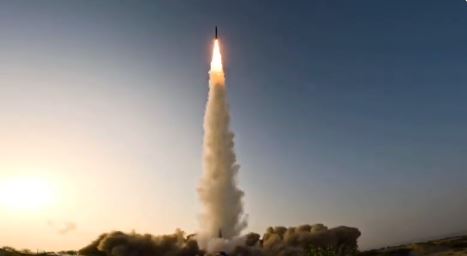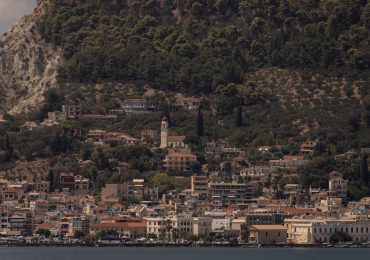IRAN allegedly used its high-tech 11,000mph hypersonic missiles for the first time to attack Israel.
Iran’s elite Revolutionary Guards claimed they fired the ballistic missiles to blitz Israel in an attack dubbed “Operation True Promise 2.”
Tansim MilitaryIran claimed it fired a hypersonic missile for the first time[/caption]
RexA barrage of rockets were fired from Iran on Tuesday[/caption]
Iran’s hypersonic missile dubbed Fattah was unveiled last year
ReutersSmoke billows in the sky after an Israeli air strike on a village in Lebanon[/caption]
APAn Israeli mobile artillery unit fires a shell from northern Israel towards Lebanon[/caption]
The missile dubbed “Fattah” -meaning “Victory” was unveiled at a grand ceremony last year.
Iran describes the Fattah-1 as a “hypersonic” missile which means it travels at Mach 5 – five times the speed of sound.
Iran said the deadly weapon can target “the enemy’s advanced anti-missile systems and is a big generational leap in the field of missiles”.
General Amir Ali Hajizadeh, commander of Iran’s Revolutionary Guards aerospace wing, claimed at the time the rocket “can manoeuvre in and out of the atmosphere”.
However, experts have cast doubt over the description “hypersonic” noting that nearly all ballistic missiles reach hypersonic speed when they’re fired.
The missile purportedly has a range of 870 miles – far enough to strike targets in Israel from Iran.
It reportedly uses a solid-fuel rocket which means it can be pre-loaded and kept on standby for launch at short notice.
It comes as…
Israel ‘preparing to blast Iran’s oil fields’ in revenge
UK helped fend off 181 Iran missile blitz with Typhoon jets
Middle East on brick of all-out war as Israel vows retaliation
At least six people shot dead in ‘terror attack’ in Israeli city Tel Aviv
Elite IDF paratroopers & commando units launch ground invasion of Lebanon
Israel vows to ‘crush Hezbollah’ after launching ‘Northern Arrows’ invasion
Israel declares no-go zone for Lebanese civilians south of the Litani River
UK Government charters emergency flight out of Lebanon for fleeing Brits
Hajizadeh also claimed last year that this weapon “cannot be destroyed by any other missile due to how it moves in different directions and at different altitudes.”
Iran claimed the missiles took less than 15 minutes to reach targets in Israel – including Mossad’s headquarters in Glilot near Tel Aviv.
Tuesday’s missile attack saw Tehran unleashing a barrage of 180 missiles at Israel.
It is the second attack by Iran this year, as it launched more than 320 missiles and drones at Israel in April.
Israelis scrambled for bomb shelters as air raid sirens sounded and the orange glow of missiles streaked across the night sky.
Shocking footage showed the moment a news reporter ducked for cover while live on air as scores of missiles were flying over Tel Aviv.
Alerts sounded across Israel late on Tuesday afternoon after US satellites picked up ballistic missiles being moved to launch sites in the west of Iran.
Defence rockets intercepted most in the skies above Tel Aviv, Jerusalem and Haifa.
I was sitting eating a pizza – moments later I was running for my life
by Nick Parker, Foreign Editor, in northern Israel
I’D just ordered a coffee in a roadside cafe on my way back from Israel’s northern war zone when the alert flashed up on my phone.
It read: “Iran is preparing an imminent ballistic missile attack against Israel. Please take cover as soon as possible.”
I was sitting in a pizza restaurant in a much-rocketed area north of the coastal port of Haifa when the warning pinged in my pocket.
Moments later I saw other diners picking up their phones as warnings reached them but was impressed by their stoicism as they carried on munching on their margaritas.
These were people who have endured daily rocket attacks from Hezbollah for nearly a year but even they began to shuffle in their seats as more warnings appeared on their mobile security apps.
This was clearly something much bigger than the daily Hezbollah barrage from the north.
And moments later we were jammed in the door as it was confirmed that more than a hundred Iranian ballistic missiles flying at 14 times the speed of sound were on their way.
This was confirmed to be only the first of several waves of attacks heading out way.
We ran across the road into a concrete shelter where English speakers told me to expect to be stuck there for some time as I tapped out my story using the glow of my laptop screen.
Then moments later the first booms split the air high above as Iron Dome interceptors engaged the incoming rockets.
I – probably very foolishly – took a sneak peek into the sky outside and watched trails of red rockets racing up to meet the missiles in a spectacular but potentially deadly firework display.
But scary spectaculars like this have become a way of life for the people of northern Israel – who clearly trust the boffins whose rocket wizardry had saved their lives yet again.
It remained unclear whether Iran’s terror masters had inflicted death or destruction as they attempted to decimate their hated enemy.
And this may be just the first of many terrifying tests for the people of Israel, their enemies and the millions caught in the crossfire as the threat of a catastrophic war looms.
The Sun understands that British Typhoon fighter jets were scrambled from RAF Akrotiri in Cyprus as Iran unleashed its attack.
Last night, Defence Secretary John Healey said: “British forces have this evening played their part in attempts to prevent further escalation in the Middle East.
“I want to thank all British personnel involved in the operation for their courage and professionalism.”
And at least six people were shot dead in a suspected terror attack in Tel Aviv while people were scrambling for shelter.
Israeli PM Netanyahu vowed to respond to Iran’s blitz saying it “made a big mistake and it will pay for it.”
Israel could target oil production facilities inside Iran within days, Israeli officials told Axios.
“The regime in Iran does not understand our determination to defend ourselves and our determination to retaliate against our enemies,” he added.
Washington said it would work with Israel to ensure Iran faced “severe consequences” for the missile attack.
Meanwhile, Israel continued its operations in Lebanon with at least five airstrikes in Beirut early this morning.
The IDF said that regular infantry and armoured units were joining ground operations in southern Lebanon, but noted they would remain limited and localised in scope.
The addition of infantry and armoured troops from the 36th Division, including the Golani Brigade, the 188th Armoured Brigade and the 6th Infantry Brigade, suggests that the operation has moved beyond limited commando raids.
APThe aftermath of an Israeli airstrike in Lebanon[/caption]
APCivilians looking through the rubble after an Israeli airstrike in Beirut[/caption]
Hezbollah’s decade of destructive preparation
By Foreign News Reporter Juliana Cruz Lima
Following the 2006 Lebanon War, in which Israel and Hezbollah fought to a bloody standstill, the terror group began preparing for the next conflict.
They constructed a vast underground network across southern Lebanon.
The lessons of that war, in which Hezbollah’s small, mobile units were able to surprise and sometimes overpower Israeli forces, have been embedded in its military doctrine ever since.
The tunnels are now a key part of this strategy, allowing Hezbollah to replicate the tactics of insurgencies around the world: strike fast, disappear, and use the enemy’s size and strength against them.
Some of these tunnels have been found stretching into Israeli territory, designed to facilitate surprise raids deep inside northern Israel.
In 2018, the IDF launched Operation Northern Shield, a months-long mission to detect and destroy Hezbollah’s cross-border tunnels.
The discovery of these tunnels — some reinforced with concrete and running dozens of meters underground — revealed just how advanced Hezbollah’s capabilities had become.
Last month, Hezbollah revealed its hidden terror tunnel network from which missiles can be launched in a chilling threat to Israel.
A blood-curdling video released by the Lebanese terrorists revealed a giant underground roads with enough room for lorries to transport their deadly weapons.
Posters of leaders and soldiers adorn the tall stone walls as heavily armed men speed through the “missile city” in motorbikes.
Trucks loaded with enormous missiles make their way through the dark roads in a frightening glimpse of the terrorists’ arsenal.
Drone footage then shows the seemingly endless terror maze, which also appears to be home to military tech and computers.
Inside the terror tunnels, Hezbollah fighters can move unseen, store weapons, and launch ambushes, creating a dangerous cat-and-mouse game with the IDF.
They can also move into a much larger network of bunkers, missile silos, and command centres, deeply embedded in civilian areas.
These tunnels – which can stretch for miles – link critical positions, allowing Hezbollah fighters to emerge, strike, and then vanish back underground before Israel can respond.
Reports also suggest that Hezbollah has been expanding its tunnel network in southern Lebanon in recent weeks.









